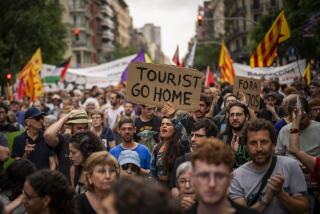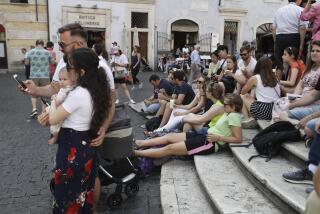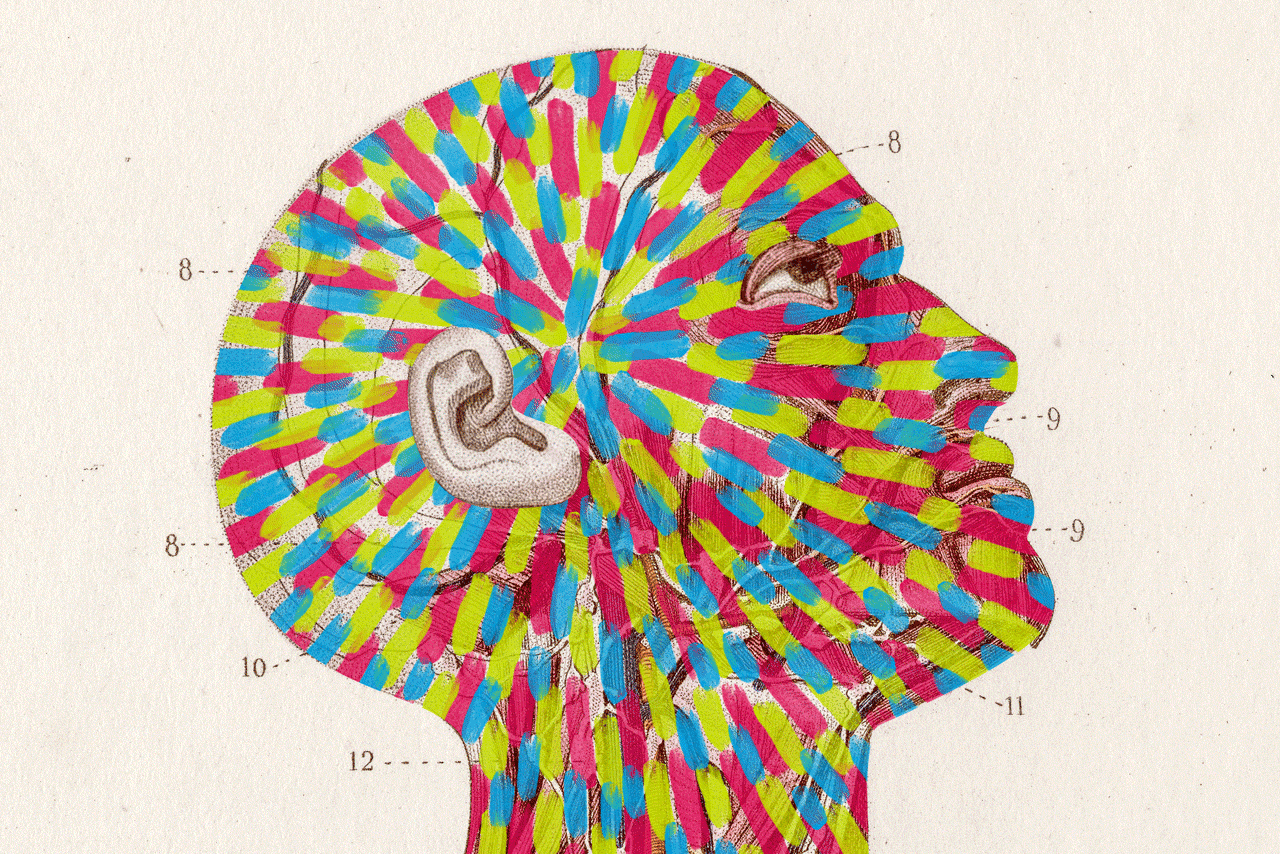Prey to Stendhal Syndrome : Beauty of Florence’s Art Distresses Some Tourists
- Share via
FLORENCE, Italy — Last summer, a Swedish tourist visiting Florence’s artistic landmarks went to Santa Maria Novella church, a 13th-Century jewel renowned for its dazzling frescoes. Something happened to her in the church. She emerged panic-stricken and disoriented, unable to cope.
Doctors who saw her a few hours later recognized the symptoms. They made a quick diagnosis: The Swedish tourist had fallen prey to the Stendhal Syndrome.
Since 1978, psychiatrists at Santa Maria Nuova Hospital here have treated 110 foreign tourists with the same psychic affliction. They believe that exposure to Florence’s great works of art serves as a catalyst for some sensitive, psychically charged foreign visitors, plunging them into mental turmoil. Suddenly, they are confronted by mental distress that could be successfully internalized at home, but not in a provocative foreign setting.
More, the doctors say that the malady is not new in a Renaissance capital whose concentration of artistic beauty has attracted travelers for centuries. It happened to the French author Stendhal, the pseudonym of Marie Henri Beyle, nearly 200 years ago, they say. It also seems to be happening to modern day tourists in other emotion-stirring cities such as Venice and Jerusalem.
“Don’t tell people they’ll go crazy if they come to Florence and look at paintings,” cautioned Graziella Magherini, director of psychiatry at the hospital and co-author with colleague Augusto Zanobini of a study published this month entitled “Events and Psychopathology: Art Tourism as an Upsetting Event.”
“Florence doesn’t cause the problems; the patients bring their troubles with them. Their encounter with works of art can trigger dramatic reactions to problems that are already there,” Magherini said in an interview.
Most at risk, she said, are the small minority of visitors who are especially sensitive to change and extremely fragile in their personal relationships. “They are the ones most susceptible to the impact of new surroundings, especially when they are teeming with art and history,” she said. “The majority come to a city of art in the same way they go to the beach or a ski resort: to enjoy themselves. Nothing ever happens to those who come to eat pizza and write post cards.”
Under the auspices of the Florence provincial government, Magherini has embarked on more detailed research with a team of two psychiatrists, a psychologist, an architect, a statistician, a literary historian and a sociologist.
If there is official interest, there is hardly civic alarm. The odds of coming away from the splendors of Florence in an unaltered state are surpassingly good. In 1986, a total of 1,143,893 foreign tourists visited Florence, and only a handful wound up under psychiatric care at the hospital, whose central location makes it a magnet for ailing visitors.
‘I’ve Never Seen It’
“I’ve heard reports of the malady, but in 11 years as an information officer I’ve never seen it or had a tourist ask about it,” said Rossano Ossi, who works for the Florence Tourist Board.
A literature buff, Magherini whimsically dubbed tourist disorders the Stendhal Syndrome after reading the novelist’s account of his own discomfiture. After visiting the tombs of Michelangelo, Galileo and Machiavelli in Santa Croce church in January, 1817, Stendhal felt overwhelmed.
“Everything speaks so vividly to my soul. Ah, if I could only forget,” he wrote. “On leaving Santa Croce, I had palpitations of the heart, what in Berlin they call ‘nerves.’ Life was drained from me. I walked with the fear of falling. . . . I sat down on a bench. . . . I needed the voice of a friend with whom to share my emotion.”
Magherini notes that other famous travelers, including Henry James and Marcel Proust, wrote of similar reactions to Florence’s art, and that Sigmund Freud described his stupefaction, “a feeling of alienation,” on seeing the majesty of Athens’ Acropolis for the first time.
The Florence team will also examine tourist psychiatric hospitalizations in Venice, where, Magherini said, the problem appears to be of about the same modest numerical magnitude, but the symptoms are different.
Confusion and Panic
“Here, the complaint is most often one of confusion and panic. In Venice, it is depression with suicidal tendencies.”
Magherini is intrigued by a recent study at Efar Shaul Psychiatric Hospital in Jerusalem, which reports treating about 50 foreign tourists a year.
“For most of the hospitalized tourists (85%), this was their first visit to Israel: with the largest portion being those who came for a genuine tourist purpose--a pilgrimage,” says the Israeli study.
The suspicion among the Italian researchers is that Jerusalem’s combination of history and religion is psychically even more potent than Florence’s blend of history and art.
The Florence study analyzes 107 cases between 1978 and 1986, showing that about two-thirds of syndrome victims are between the ages of 20 and 40, most are unmarried, with men and women about equally at risk. Most patients had come alone to Florence to see the art. The Swedish woman was one of three victims so far in 1987.
“In most cases, the ghost of hostile presences appeared to us to be of prime importance,” Magherini and Zanobini wrote.
‘Sexual Excitement’
They describe the panic of a young Frenchman before the paintings of Raphael. They speak of the “psychic exaltation and sexual excitement” ignited in some patients by the painting of an adolescent Bacchus by Caravaggio.
“Michaelangelo’s David in the Gallery of the Academy was the culminating moment of impact in an anxiety crisis of another young tourist,” says the Florence study, which Magherini calls “preliminary notes.”
Most of the victims have been West Europeans, with Americans second, Magherini said. Researchers note that Italians, who make up about one-third of Florence’s tourists, appear to be immune. So do Japanese, nearly all of whom come on organized tours.
One patient was overwhelmed by fear after seeing the frescoes painted in concentric circles inside the cupola at Florence’s landmark cathedral. A woman tourist called Mary described to doctors how she felt enfeebled by “the elusiveness of objects, the beauty of a work which attracts yet which escapes.” A European journalist making his first visit to Florence told of feeling prisoner to “a succession of bell towers, bridges, piazzas, loggias, statues and imposing palaces.”
Florence has long been a captivating city. As Henry James, in his 1901 work, “Italian Hours,” wrote: “The place seems to become personified, human, sensible, part of our affections. One wishes almost to embrace it, possess it.”
According to the Italian researchers, Florence’s psychic curiosity is benign. Afflicted tourists usually snap back after two or three days of rest. Doctors urge them to seek more searching treatment in more familiar surroundings.
“The best cure is to go home,” said Magherini.
More to Read
The biggest entertainment stories
Get our big stories about Hollywood, film, television, music, arts, culture and more right in your inbox as soon as they publish.
You may occasionally receive promotional content from the Los Angeles Times.










